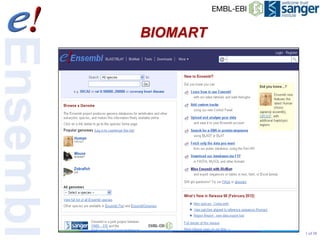Biomart
- 1. BIOMART 1 of 38
- 2. BIOMART ŌĆó Developed jointly by EBI & CSHL ŌĆó BioMart is a search engine that can find multiple terms and put them into a table format. ŌĆó Such as: human gene (IDs), chromosome and base pair position ŌĆó No programming required! 2 of 38
- 3. BIOMART ŌĆó A wide variety of analyses and tasks: ’āśSNP (single nucleotide polymorphism) ’āśselection for candidate gene screening ’āśmicroarray annotation ’āśrecovery of disease links, sequence variations and expression patterns 3 of 38
- 4. General or Specific Data-Tables ŌĆó All the genes for one species ŌĆó OrŌĆ” only genes on one specific region of a chromosome ŌĆó OrŌĆ” genes on one region of a chromosome associated with a disease 4 of 38
- 5. BioMart Data Sets ŌĆó Ensembl genes ŌĆó Vega genes ŌĆó SNPs ŌĆó Markers ŌĆó Phenotypes ŌĆó Gene expression information ŌĆó Gene ontology ŌĆó Homology predictions ŌĆó Protein annotation 5 of 38
- 6. Web Interface 6 of 38
- 7. Simple Text-based Search Engine 7 of 38
- 8. ŌĆśMouse GeneŌĆÖ Gives Us Results 8 of 38
- 9. A More Complex Query is Not as Useful 9 of 38
- 10. BioMart Walkthrough ŌĆó Glucose-6-phosphate dehydrogenase (G6PD) human gene located on chromosome X in cytogenetic band q28. ŌĆó Which are the other genes in relevance to human diseases locate to the same band? ŌĆó Find out their Ensembl Gene IDs and Entrez Gene IDs? ŌĆó And also find out their cDNA sequences? 10 of 38
- 11. Information Flow ŌĆó Choose the species of interest (Dataset) ŌĆó Decide what you would like to know about the genes (Attributes) (sequences, IDs, descriptionŌĆ”) ŌĆó Decide on a smaller geneset using Filters. (enter IDs, choose a region ŌĆ”) 11 of 38
- 12. Choose ŌĆ×Ensemble Genes 66ŌƤas a primary database 12 of 38
- 13. Choose ŌĆ×Homo sapiensŌƤ as the species of interest 13 of 38
- 14. On the left narrow the gene set by clicking ŌĆ£FiltersŌĆØ. In front of ŌĆ£REGIONŌĆØ, click on the ŌĆ£+ŌĆØ to expand the choices. Filters: what we know 14 of 38
- 15. Select ŌĆ£Chromosome XŌĆØ Select ŌĆ£Band Start q28ŌĆØ and ŌĆ£End q28ŌĆØ 15 of 38
- 16. Expand the ŌĆ£GENEŌĆØ panel. 16 of 38
- 17. Limit to genes with MIM disease IDŌĆÖ. These associations have been determined using MIM (Online Mendelian Inheritance in Man). 17 of 38
- 18. The filters have determined our gene set. Click ŌĆ×CountŌƤ to see how many genes have passed these filters. 18 of 38
- 19. The ŌĆ×CountŌƤ results show 26 human genes out of 56478 total genes passed the filters. Click on ŌĆ×AttributesŌƤ to select output options (i.e. what we would like to know about our gene set). 19 of 38
- 20. Expand the ŌĆ×GENEŌƤ panel. 20 of 38
- 21. Select, along with the default options, ŌĆ×Associated Gene nameŌƤ (this shows the gene symbol from HGNC). Note the summary of selected options. The order of attributes determines the order of columns in the result table. 21 of 38
- 22. Expand the ŌĆ×EXTERNALŌĆÖ panel to select External References. 22 of 38
- 23. Select ŌĆ×EntrezGene IDŌƤ and ŌĆ×Mim Morbid AccessionŌƤ andŌĆ×MIM Morbid DescriptionŌƤ. 23 of 38
- 24. Click ŌĆ×RESULTSŌƤ to preview the output. 24 of 38
- 25. To save a file of the complete table, click ŌĆ×GoŌƤ. Go back and change Filters or Attributes if desired. Or, View ALL rows as HTMLŌĆ” 25 of 38
- 26. Result 26 of 38
- 27. Select ŌƤSequencesŌƤ and then expand the ŌĆ×SEQUENCESŌƤ section. To view sequences, go back to ŌĆ×AttributesŌƤ 27 of 38
- 28. Expand the ŌĆ×SEQUEN CESŌƤ panel and select cDNA sequences Expand the ŌĆ×Header InformationŌƤ section. 28 of 38
- 29. Choose ŌĆ×Ensembl Gene IDŌƤ, ŌĆ×Associated Gene NameŌƤ, ŌĆ×ChromosomeŌƤ, and ŌĆ×Ensembl Transcript IDŌƤ 29 of 38
- 30. Click ŌĆ×ResultsŌƤ 30 of 38
- 31. 31 of 38
- 32. Many BioMarts have now been installed by external groups, in large part because of its automated deployment tools and compatibility cross different platforms. Some of the groups are model organism databases such as Gramene, Dictybase, Wormbase, HapMap variation. 32 of 38
- 33. Central Server www.biomart.org 33 of 38
- 34. WormBase 34 of 38
- 36. DictyBase 36 of 38
- 37. Uniprot, MSD 37 of 38
- 38. GRAMENE Rice, Maize, Arabidopsis genomesŌĆ” 38 of 38
- 39. Thanks 39 of 38







































